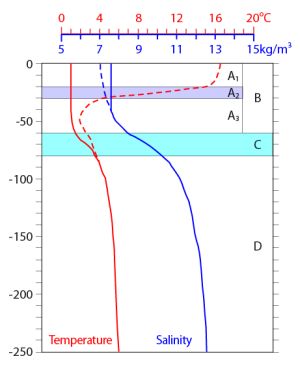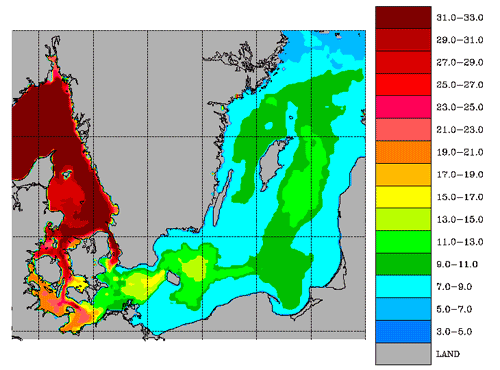|
Background > Oceanography
The unique physical characteristics of the Baltic Sea
Stratification and vertical gradients
The Baltic Sea is the second largest brackish water intracontinental shelf sea in the world (the Black Sea, which has similar biogeochemical characteristics, is slighly larger). Most of the Baltic Sea, as most waters in the boreal to temperate climate zone, is strongy stratified and shows a distinct seasonality. This means that different water layers remain stable on top of each other over a long period of time. Thermal stratification is due to the warm surface layer which is exposed to the warming of the sun. As warm water is less heavy that cold water, a stable warm water layer sits ontop of a cold layer below. Usually, there is a sharp transition zone between the two layers, called the thermocline. In winter, the surface water cools down and sinks, which results in a mixing of the upper 60-80 m, which is enhanced by storms in autumn and winter. In spring and early summer, the sun warms the surface layers, and a thermocline can re-establish.
 |
A1 = Warm upper summer water
A2 = Thermocline
A3 = Cold intermediate winter water
B = Mixed layer
C = Halocline
D = Deep water
Hatched lines show summer values |
There is also a pronounced vertical salinity gradient: due to the freshwater inflow from the catchment basin, the surface layer is less saline that the heavier deep saline water. This results in a permanent discontinuity layer (the salinity discontinuity layer, "halocline"), which largely prevents effective vertical mixing, with profound consequences for the biogeochemical conditions in the Baltic Sea, as these deep heavy waters are rarely refreshed and form large areas of oxygen-free deep water. In the absence of oxygen, microbiological processes produce hydrogen sulfide and are also responsible for other particularities (see here).
Fresh water from the Atlantic
A significant exchange of the stagnant anoxic deep water only occurs every few years, when strong westerly storms push salty, oxygenated deep water into the western Baltic Sea through the Danish Straits. These events are called "Major Baltic Inflows" (MIBs). The animation below shows the inflow event of highly saline bottom water into the western Baltic Sea between January and March 2003. The animation shows a model run of the BALTEX Integrated Model System BALTIMOS, visualizing the real inflow event. These inflow events occur very irregularly, in time scales of tens of years.

The horizontal salinity gradient
One of the outstanding characteristics of the Baltic Sea is its pronounced horizontal salinity gradient. In the open ocean, the salinity is about 34 (corresponding to 34 g salt per litre), while rivers and lakes generally have a salinity close to zero. The Baltic Sea shows the complete range: from 33 in the Skagerrak (entrance to the North Sea) to less that 3 in the northern Bothnian Bay. This has profound consequences for the distribution of animals, as each species has a salinity range at which is is most comfortable.
For more information, click here.
|

